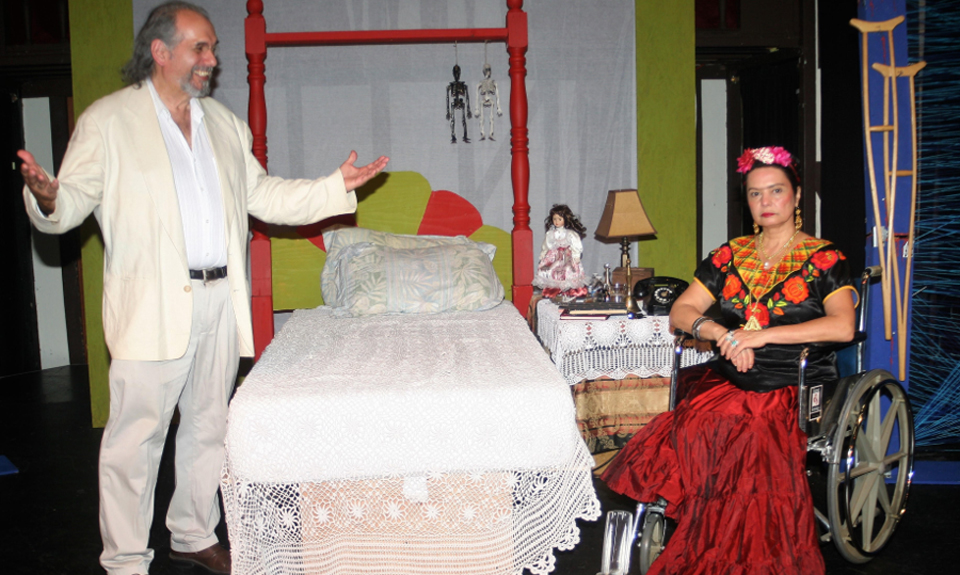
LOS ANGELES—If Howard Zinn penned “People’s Histories” and Oliver Stone filmed “Untold Histories,” Latinx playwright Odalys Nanin’s modus operandi is to write (or rewrite?) allegedly biographical plays about famous women revealing their same-sex affairs. I previously saw Nanin’s stage exposés purporting that Greta Garbo and Marilyn Monroe had their Sapphic episodes. Some may regard this as a breakthrough, disclosing the hitherto concealed, unvarnished lesbian truth. Some may react with puritanical disbelief and outrage that their beloved sex goddess has been thusly tarred and defamed. Still others could respond with a collective yawn, musing, “That’s so 20th century” or “So what, who cares?” Take your pick.
Be that as it may, now the Mexican painter and revolutionary Frida Kahlo is getting the Nanin treatment in Frida, Stroke of Passion, starring Nanin herself, who also, coincidentally, directs. The two-acter takes place in July 1954 during the last week or so of Frida’s tumultuous, often tortured life. The drama plays out like a sort of fever dream as the tequila-swilling, pill-popping Frida remembers her many lovers—most of them, for the purposes of this play, women.
Except, notably, her relations with Mexican Marxist muralist Diego Rivera. As depicted onstage, their relationship was stormy. In real life they married, divorced and then remarried. Diego and Frida had the kind of romance where the only thing more unbearable for them than being apart was being together, as Stroke dramatizes. Unfortunately, Oscar Basulto’s Diego comes across as a boorish buffoon and looks like Herman Munster.
Among the parade of Frida’s female lovers, my favorite was Celeste Creel as singer/dancer Josephine Baker. Clad in little more than Baker’s celebrated banana skirt, Creel dances a rather sexy Charleston, stealing a show that’s frequently depressing. Of course, to be fair, Frida suffered a terrible accident in her youth and, alas, did not live long, so the subject has an inherent gloominess attached to it.
Apropos for a production about painters, Nanin’s play has a vivid visual sense, including Marco de Leon’s set, and overhead screens with projections that range from overhead live shots of the stricken Frida lying in bed to rather effective evocations of Kahlo’s own artwork. Frida has some visually magical moments, but unlike some blabbermouth tattletales—uh, I mean “reviewers”—I won’t ruin your surprise by divulging them here should you have the opportunity to see this play sometime.
Frida makes some eye-opening allegations about the possible implication to some degree of Diego and Frida in the assassination of Russian revolutionary Leon Trotsky (Paul Cascante), whom Kahlo romanced. Generally, Diego and Frida have been depicted as Trotsky’s champions, who helped the exiled communist to find refuge in Mexico, provided him with a home and defended the on-the-run onetime Red Army leader, as in Julie Taymor’s 2002 Frida film, starring Salma Hayek as Kahlo, Alfred Molina as Rivera, and Geoffrey Rush as the doomed Bolshevik.
I don’t know if Nanin’s version of Trotsky’s liquidation is historically accurate or a lot of “bull-shevik.” The playwright told me she did lots of research for her subject, but the only source she cited to me re Trotsky was a Russian TV series about him that played on Netflix—which has been questioned regarding its historical accuracy, including its dramatization of Trotsky’s murder. I personally don’t know if Nanin’s accusations are correct, but if she has indeed defamed these two great artists by implicating them in the Russian’s elimination it could be called “the second assassination of Trotsky.”
Nanin’s play also explores the strange circumstances of Kahlo’s death, which some may find to be controversial and eyebrow-raising.
Frida has lots of details about poor Frida’s all-too-short life (her bulb burnt briefly but brightly) if maybe there’s TMI about her intimate life. Unless a private or public figure (and those they have been involved with) has given explicit permission to let it all hang out for the world to gawk at, as titillating as it may be, the rationale for tell-alls about private lives is a dubious proposition.
But Frida fans (several women attending the premiere wore clothing evocative of the painter, who is a cult favorite revered by many) and especially those unfamiliar with Kahlo’s life, art and politics will likely learn a lot from Nanin’s play. Given its substance abuse, simulated sex, and semi-nudity, it is probably not suited for children. Nanin’s version onstage and on the page are subject to interpretation and Frida, Stroke of Passion may be a case of “different strokes for different folks.” However, it gave me a new appreciation for Kahlo’s artwork and a desire to experience more of it.
Frida, Stroke of Passion ended its short run on Feb. 16 at Casa 0101 Theater, 2009 E. First St., Los Angeles. For more info see the company website.
Photo: Paul Cascante as Trotsky and Odalys Nanin as Frida / Antje Dohm












Comments